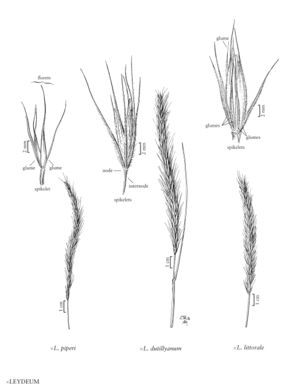×leydeum piperi
Plants shortly rhizomatous. Culms to 80 cm tall, about 1.5 mm thick. Leaves evenly distributed; sheaths smooth; auricles to 1.5 mm; ligules 0.5-0.8 mm, truncate to rounded; blades 10-20 cm long, 1.5-2.5 mm wide, tapering from near the base, abaxial surfaces scabridulous, adaxial surfaces scabrous, with about 12 usually more or less equally prominent veins, apices narrowly acute. Spikes 10-15 cm long, 10-15 mm wide including the awns, 5-7 mm wide excluding the awns, lax, nodes with 2(3) spikelets, 1 (central if 3) spikelet sessile, 1(2) spikelet(s) pedicellate, pedicels about 0.2 mm; internodes 3-5 mm, completely or mostly concealed by the spikelets; disarticulation tardy, in the rachises. Spikelets about 15 mm including the awns, about 10 mm excluding the awns, with 1-3 florets, the larger or central spikelets with 2-3 florets, the lateral or smaller spikelets with 1(2) floret(s). Glumes 10-15 mm long, about 0.2 mm wide, subulate, scabrous; lemmas glabrous, mostly smooth, scabrous distally, the largest lemmas of the larger spikelets 6-7 mm, with awns about 9 mm, the largest lemmas of the smaller or lateral spikelets about 5 mm, with awns about 5.5 mm; anthers 1.8-2.2 mm long, about 0.3 mm thick.
Discussion
Covas (1949) and Bowden (1967) agreed that that the parents of ×Leydeum piperi are Hordeum jubatum and Leymus triticoides. It is not known how common or widespread it is. It differs from ×Elyhordeum macounii in its subulate, rather than narrowly linear, glumes.
Selected References
None.
